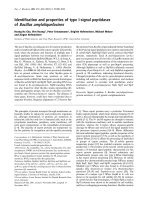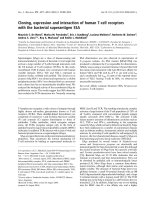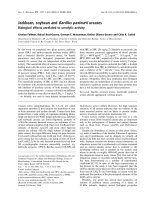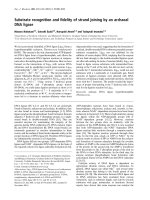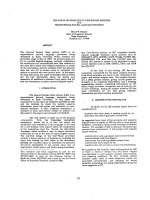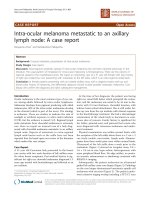báo cáo khoa học: "Membranous nephropathy and lupus-like syndrome after hematopoietic cell transplantation: a case report" doc
Bạn đang xem bản rút gọn của tài liệu. Xem và tải ngay bản đầy đủ của tài liệu tại đây (663.86 KB, 4 trang )
CAS E REP O R T Open Access
Membranous nephropathy and lupus-like
syndrome after hematopoietic cell
transplantation: a case report
Kostas Stylianou
1*
, Stavros Stratakis
1
, Vasiliki Mavroeidi
1
, Ioannis Petrakis
1
, Dimitris Xydakis
1
, Eleftheria Vardaki
1
,
Spyros Stratigis
1
, Kostas Perakis
1
, Theodora Katsarou
1
, Peggy Kanellou
2
, Irene Xylouri
2
, Constantina Petraki
3
,
Michael Alexandrakis
2
, Eugene Daphnis
1
Abstract
Introduction: The kidney is increasingly recognised as a target organ of chronic graft-versus-host disease after
hematopoietic cell transplantation in the context of the development of the nephrotic syndrome. Chronic graft-
versus-host disease is associated with autoimmune phenomena similar, but not identical, to those observed in
various rheumatologic disorders, implicating autoimmunity as an impo rtant component of the disease.
Case presentation: We report the case of a 57-year-old Caucasian man who developed the nephrotic syndrome
due to membranous nephropathy in association with recurrent chronic graft-versus-host disease, along with a
lupus-like syndrome manifested with pancytopenia, hair loss, positive anti-DNA antibodies and sub-epithelial and
mesangial immune deposits. To the best of our knowledge, this is the first case reported in the literature. The
nephrotic syndrome subsided soon after he was treated with a short course of cyclosporin with steroids.
Unfortunately he died seven months later due to a relapse of leukemia.
Conclusions: Our case report confirms the notion that chroni c graft-versus-host disease is characterized by the
appearance of autoimmune phenomena similar, but not identical, to tho se seen in autoimmune diseases. The
decision for more immunosuppression has to be weighed against the need for preservation of the graft versus
leukemia phenomenon.
Introduction
Acute graft-vers us-host disease (aGVHD) has tradition-
ally been defined as a syndrome occurring during the
first 100 days following allogeneic hematopoietic cell
transplant (HCT). aGVHD occurs in 9 to 50 percent of
patients who receive HCT, despite intensive prophylaxis
with immunosuppressive agents [1].
Chronic graft- versus-host disease (cGVHD), by defini-
tion, appears over 100 days after HCT and is associated
with autoimmune phenomena [2]. Auto-antibodies
found in patients with cGVHD are similar, but not iden-
tical, to those observed in various rheumatologic dis-
orders, implicating autoimmunity as an important
component of cGVHD [3].
The kidney is increasingly recognised as a target organ
of cGVHD in the context o f the development of the
nephrotic syndrome (NS) [4-9]. We report the case of a
man who developed NS due to membranous nephropa-
thy (MN), three years after HCT, along with clinical and
laboratory findings resembling systemic lupus erythema-
tosus (SLE).
Case presentation
A 57-year-old Caucasian man was referred to our renal
ward when he was found to have developed NS. Five
years earlier, he had been diagnosed with acute myelo-
genous leukemia (AML-M2) for which he received
induction therapy with cytarabine and idarubicin fol-
lowed by mitoxantrone and VP-16, with complete
response. One year l ater he underwent HCT from his
HLA-identical sister at his first relapse. The ir compat-
ibility was complete for HLA A
1,24
,B
8,35
,C
W4,7
,B
W6
,
* Correspondence:
1
Nephrology Department, Heraklion University Hospital, PO Box 1352, 71110
Heraklion, Crete, Greece
Full list of author information is available at the end of the article
Stylianou et al. Journal of Medical Case Reports 2010, 4:303
/>JOURNAL OF MEDICAL
CASE REPORTS
© 2010 Stylianou et al; licensee BioMed Central Ltd. This is an Open Access article distributed under the te rms of the Creative
Commons Attribution License ( which permits unrestricted use, distribution, and
reproduction in any medium, provided the original work is properly cited.
DR
11
,DR
W52
,DR
B1
,DR
B2
and the transplant came from
peripheral blood stem cells. Busulfan and cyclophospha-
mide were given as a conditioning regimen and cyclos-
porin plus methotrexate as a prophylaxis for GVHD.
Methotrexate was discontinued at day 30 and cyclos-
porin was gradually tapered until it was stopped at six
months. Despite prophylaxis, he developed extensive
cGVHD with widespread skin eruption and elevated
liver enzymes eight months after HCT. He was then
restarted on cyclosporin for two months and prednisone
which was discontinued 12 months later when all signs
and symptoms of cGVHD had subsided. After cessation
of the immunosuppressants, he gradually developed
hypertension, proteinuria (2 g/d), mild creatinine eleva-
tion (133 μmol/L) and elevated liver enzymes (SGOT
200 U/L, SGPT 207 U/ L, ALP 197 U/L, LDH 479 U/L).
Reinstitution of prednisone resulted in a clinical
improvement but six months after the cessation of ster-
oids he developed NS with anasarca, proteinuria (4 g/d),
hypoalbuminemia (1 .7 g/dl), and elevated serum crea ti-
nine (150.3 μmol/L). An attempt by the treating physi-
cianstoobtainkidneytissuebyabiopsywasnot
successful at this time so he was empirically commenced
on furosemide (80 mg /d), enalapril (10 mg/d) and
methylprednisolone (48 mg/d) with subsequent
improvement of proteinuria and his renal function.
One year later, when steroids had been withdrawn due
to a worsening cataract, he presented with pancytopenia,
alopecia and a relapse of NS. At this point he was referred
to the renal ward of our hospital for the first time. On
clinical examination, he was apyrexial with pitting edema
in both of his legs, loss of hair in his armpits and on his
head, and poikiloderma lesions on his arms and trunk. A
laboratory investigation showed the following: hemoglobin
9 g/dl; white blood cell count 4800/μl (28 percent neutro-
phils, 60 percent lymphocytes, 12 percent monocytes, no
blasts); platelet s 98000/μl; serum creatinine 212 μmol/L;
increased liver enzymes (SGOT 97 U/L, SGPT 51 U/L,
ALP 235 U/L, LDH 578 U/L); and nephrotic range protei-
nuria 4.3 g/d. Urine analysis showed increased erythro-
cytes (20/HPF, 70 percent dysmorphic), few mixed casts
(consisting of white blood cells, tubular epithelial cells and
rare erythrocytes), few oval fat bodies and plenty of hyaline
casts. Virology tests for human immunodeficiency virus
(HIV), cytomegalovirus (CMV), hepatitis B virus (HBV)
and hepatitis C virus (HCV) were negative. His serum
immunoglobulins, C3, C4, rheumatoid factor, anti-mit-
ochondrial antibodies and anti-nuclear cytoplasmic anti-
bodies (ANCA) were all normal. A direct Coomb’stest
was negative, anti-nuclear antibodies (ANA) were positive
(1/320 diffuse staining) and anti-dsDNA antibodies were
also positive by enzyme- linked immunosorbent assay
(ELISA) (74 IU/ml). However, the crithidia luciliae immu-
nofluorescence test (CLIFT) was negative.
A bone-marrow biopsy did no t display any recurrence
of the leukemia, while a chimerism analysis showed
complete donor-type cells. At this point, a renal biopsy
was perform ed to elucidate the underlying cause of pro-
teinuria. The kidney specimen contained 31 glomeruli.
Six of them were globally sclerotic and three had seg-
mental sclerosis. The remaining 22 showed mild thick-
ening of the capillary walls with segmental spike
formation. Immunohistochemistry revealed diffuse
deposits of IgG and C3 on the outer aspect of his glo-
merular capillary wall and segmental mesangial IgM
deposits. Electron microscopy showed diffuse sub-
epithelial deposits and foot processes fusion. These find-
ings were consistent with MN stage I, accompanied by
focal sclerotic lesions (Figure 1).
Complete resolution of the NS, improvement of his
renal function (serum creatinine 168 μmol/L) and a
restoration of pancytopenia were achieved within two
months of treatment with cyclosporin (150 mg/d) and
methylprednisolone (36 mg/day) with subsequent
tapering.
Six months later, he manifested a relapse of acute leu-
kemia. He refused to undergo a second transplant with
a reduced intensity preparative regimen, so an attempt
was made to achieve remission by chemotherapy alone.
Unfortunately he died of sepsis one month later.
Discussion
Most cases of NS post HCT develop a few months after
minimization or cessation o f a GVHD prophylaxis regi-
men [6-10]. The principal histo logical entity reported is
MN followed by minimal change disease, while other
diagnoses are very rare. Almost all patients have pre-
sented some kind of GVHD (acute or chronic) prior to
the development of proteinuria. The treatment of the
NS post HCT is achieved mainly by steroids and cyclos-
porin [6-10].
To the best of our knowledge, this is the first reported
case of a patient with MN post HCT f ulfilling the clini-
cal and laboratory criteria for the diagnosis of SLE (pan-
cytopenia, glomerulonephritis, high anti-dsDNA titres
and hair loss). Another reported patient with positive
anti-dsDNA antibodies was a 12-year old girl who devel-
oped minimal change disease (MCD) after an umbilica l-
cord blood transplantation, without other manifestations
of SLE [11] . The presence of segmental IgM deposi ts in
the mesangium supports the diagno sis of secondary MN
which, in connection with the positive anti-dsDNA anti-
bodies, raises the possibility of a membranous nephropa-
thy secondary to lupus. Ne vertheless, alopecia and
immune cytopenias are both well-known features of
cGVHD, while IgM deposits in the mesangium have
been reported in few other cases of glomerulo nephritis
post HCT [7]. Moreover, the temporal association of
Stylianou et al. Journal of Medical Case Reports 2010, 4:303
/>Page 2 of 4
proteinuria with recurrent cGVHD manifestations, the
rapid resolution of NS after a short course of cyclos-
porin and steroids, the diffuse ANA staining pattern and
the negative CLIFT test, reduce the po ssibility of a true
lupus MN and make more likely the diagnosis of an
MN secondary to cGVHD with associated lupus-like
manifestations.
Finally, our case report also raises the possibility that a
more intensive blockade of the renin-angiotensin system
with less immunosuppression may be more appropriate
for the treatment of NS post HCT.
Conclusions
NS post HCT is a late complication usually presenting
after withdrawal of GVHD prophylaxis therapy. cGVHD
is characterized by the appearance of autoimmune phe-
nomena similar, but not identical, to those seen in auto-
immune diseases. The decision for more
immunosuppression has to be wei ghed against the n eed
for preservation of the graft versus leukemia
phenomenon.
Consent
Written informed consent was obtained from the
patient’s next-of-kin for publication of this case report
and any accompanying images. A copy of the written
consent is available for review by the Editor-in-Chief of
this journal.
Abbreviations
aGVHD: acute graft-versus-host disease; AML: acute myelogenous leukemia;
ANA: anti-nuclear antibodies; ANCA: anti-nuclear cytoplasmic antibodies;
cGVHD: chronic graft-versus-host disease; CLIFT: crithidia luciliae
immunofluorescence test; CMV: cytomegalovirus; ELISA: enzyme-linked
immunosorbent assay; HBV: hepatitis B virus; HCV: hepatitis C virus; HCT:
hematopoietic cell transplantation; HIV: human immunodeficiency virus; HLA:
human leukocytes antigen; HPF: high power field; MCD: minimal change
disease; MN: membranous nephropathy; NS: nephrotic syndrome; SLE:
systemic lupus erythematosus.
Author details
1
Nephrology Department, Heraklion University Hospital, PO Box 1352, 71110
Heraklion, Crete, Greece.
2
Hematology Department, Heraklion University
Hospital, Crete, Greece.
3
Department of Pathology, Evaggelismos Hospital,
Athens, Greece.
Authors’ contributions
KS, SS, VM, IP, DX, EV, SS, KP, TK, PK, IX, CP, MA, ED were involved in patient
care in the hematology unit and the renal unit, acquisition of data, analysis
and interpretation of data, review of the literature, and drafting and revising
the manuscript. All authors read and approved the final manuscript.
Competing interests
The authors declare that they have no competing interests.
Received: 8 November 2009 Accepted: 10 September 2010
Published: 10 September 2010
Figure 1 A. Mild thickening and ri gidit y of the glomerular capillary walls wit h slight d ilatat ion of the capillary lumens [JMSx400];
B. Focus of tubular atrophy and interstitial fibrosis (white arrow), global wrinkling and sclerosis of a glomerulus (white arrowhead)
[JMSx200]; C. IgG immunohistochemical expression in glomerular capillary walls (black arrows) [IgGx400]; D. Sub-epithelial dense
deposits (white arrow), effacement of epithelial foot processes and segmental spike formation (×13000).
Stylianou et al. Journal of Medical Case Reports 2010, 4:303
/>Page 3 of 4
References
1. Reddy P: Pathophysiology of acute graft-versus-host disease. Hematol
Oncol 2003, 21:149-161.
2. Higman M, Vogelsang GB: Chronic graft versus host disease. Br J
Haematol 2004, 125:435-454.
3. Tyndall A, Dazzi F: Chronic GVHD as an autoimmune disease. Best Pract
Best Pract Res Clin Haematol 2008, 21:281-289.
4. Rao PS: Nephrotic syndrome in patients with peripheral blood stem cell
transplant. Am J Kidney Dis 2005, 45:780-785.
5. Srinivasan R, Balow JE, Sabnis S, Lundqvist A, Igarashi T, Takahashi Y,
Austin H, Tisdale J, Barrett J, Geller N, Childs R: Nephrotic syndrome: an
under-recognised immune-mediated complication of non-myeloablative
allogeneic haematopoietic cell transplantation. Br J Haematol 2005,
131:74-79.
6. Brukamp K, Doyle AM, Bloom RD, Bunin N, Tomaszewski JE, Cizman B:
Nephrotic syndrome after hematopoietic cell transplantation: do
glomerular lesions represent renal graft-versus-host disease? Clin J Am
Soc Nephrol 2006, 1:685-694.
7. Chang A, Hingorani S, Kowalewska J, Flowers ME, Aneja T, Smith KD,
Meehan SM, Nicosia RF, Alpers CE: Spectrum of renal pathology in
hematopoietic cell transplantation: a series of 20 patients and review of
the literature. Clin J Am Soc Nephrol 2007, 2:1014-1023.
8. Troxell ML, Pilapil M, Miklos DB, Higgins JP, Kambham N: Renal pathology
in hematopoietic cell transplantation recipients. Mod Pathol 2008,
21:396-406.
9. Chan GS, Lam MF, Au WY, Chim S, Tse KC, Lo SH, Fung SH, Lai KN,
Chan KW: Clinicopathologic analysis of renal biopsies after
haematopoietic stem cell transplantation. Nephrology (Carlton) 2008,
13:322-330.
10. Lin J, Markowitz GS, Nicolaides M, Hesdorffer CS, Appel GB, D’Agati VD,
Savage DG: Membranous glomerulopathy associated with graft-versus-
host disease following allogeneic stem cell transplantation. Report of 2
cases and review of the literature. Am J Nephrol 2001, 21:351-356.
11. Lee JH, Kwon BS, Ha IS, Cheong HI, Moon KC, Ahn HS, Choi Y: Nephrotic
syndrome in a child after umbilical-cord-blood transplantation. Pediatr
Nephrol 2006, 21:1312-1317.
doi:10.1186/1752-1947-4-303
Cite this article as: Stylianou et al.: Membranous nephropathy and
lupus-like syndrome after hematopoietic cell transplantation: a case
report. Journal of Medical Case Reports 2010 4:303.
Submit your next manuscript to BioMed Central
and take full advantage of:
• Convenient online submission
• Thorough peer review
• No space constraints or color figure charges
• Immediate publication on acceptance
• Inclusion in PubMed, CAS, Scopus and Google Scholar
• Research which is freely available for redistribution
Submit your manuscript at
www.biomedcentral.com/submit
Stylianou et al. Journal of Medical Case Reports 2010, 4:303
/>Page 4 of 4

